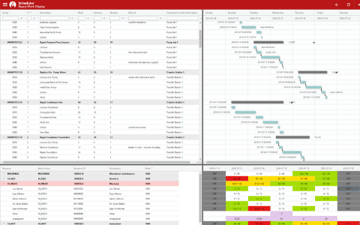Planning and scheduling are fundamental to the continuous improvement of your maintenance and asset management processes. It lays the foundation for true value in the maintenance department. This is value that can be communicated to other departments in the business.
Having job plans of some kind is better than having no job plans at all. A poorly designed schedule is still better than no schedule at all. With that said, there are good and bad ways to go about it.
The definition of best practice is deceptively simple. It’s the practice that leads to the best results. While this is simple in theory, determining exactly what constitutes a “best practice” will depend on your situation, your organization, and your industry.
However, we have noticed that there’s a common theme to what we might call “worst practice.” These are practices that detract from the value of your planning and scheduling efforts. Your organization is better off using these than simply not having any planning and scheduling, but the presence of one or more of these practices means you aren’t accomplishing everything you could be.
There are plenty of theoretical bad practices that never really come up. For example, it would be a bad practice to insist that planners wear blindfolds while visiting a job site. We don’t bother categorizing this as a “worst practice” because no one would ever think this was a good idea. Instead, we’ve concentrated on identifying practices that may look like good ideas but turn out to be detrimental to your planning and scheduling.
1. Put Your Maintenance Planners on Tools

The duty of the planner is to plan. It’s been said that if planners aren’t thinking of the future, then no one is. This makes putting your planners on tools an almost guaranteed way to lower overall effectiveness.
The best planners typically have at least ten years of experience as craftspeople, often more. In fact, it’s common for high-performing craftspeople to be promoted to the planner position based on their technical skills. This makes it very tempting to hand them a toolbox in addition to their planning duties. Planners who are relatively new to the role probably won’t need much convincing. They’re comfortable with the toolbox.
Planners who pick up tools are not concentrating on planning. Planning is a full-time job and accurate, well-developed job plans are fundamental to maintenance best practice and any program of continuous improvement.
As we mentioned above, planners are often recruited from the ranks of highly skilled craftspeople. However, a high level of technical skill is not the only attribute required. Planners who cannot keep from picking up tools might be happier returning to the previous position as craftspeople.
For an in-depth look at why planners shouldn’t be put on tools and how that ties in with other foundational planning principles, please see “6 Maintenance Planning Principles for Success in Planning & Scheduling.”
2. Tie Your Planners to Their Desks
This might seem like it’s in conflict with the point above. How can you tie them to their desks and put them on tools at the same time? The answer is simple and has the potential to wreak even more havoc than either one alone. Put them on tools…and never let them visit job sites except to work as crafts.
Planning involves a lot of desk work, but it is not a desk job. Planning best practices require that maintenance planners visit the job site to accurately assess the situation. Some safety and access issues require an onsite visit to truly understand accurately plan for, and there may be other factors occurring at the site of which the planner is unaware.
3. Plan the Same Job Over and Over and Over Again
It takes time and effort to create a good job plan. You can make sure that time and effort goes to waste by repeating work that has already been done, sometimes several times by different people over the years.
Previously planned jobs should be saved for future reference and refinement. Best practice requires you to encourage planners to get into the habit of always consulting the library of previously planned jobs. It may turn out that a job plan already exists, or that an existing plan can be modified. Building on an existing plan leaves your planners more time to refine and perfect the plan, as opposed to creating it from scratch.
Sean McWhirter of Prometheus Group notes the time you can save simply by reusing task lists and bills of materials, as well as other time-saving tips, in his blog, "How Close Are You to Planning Best Practices?"
4. Don’t Solicit Feedback on Job Plans (Or Ignore It)

Well-developed job plans are often complicated. A lot of different pieces make up a comprehensive plan, including task durations, tools and materials, quantitative descriptions of the tasks to be performed, etc. This level of complexity means that a “perfect” job plan is often the result of a long process of evolution and refinement.
Feedback from the craftspeople performing the work is essential to improving job plans in the long-term. Planners should solicit feedback directly, but the culture of your organization must encourage craftspeople to do so as well.
It’s important to remember that this feedback is a two-way street. Planners must update plans in accordance with this feedback on a regular basis, or it will stop coming. Craftspeople will stop providing feedback if they become convinced no one is listening.
5. Never or Rarely Review Your Preventive Maintenance (PM) Plans
Preventive maintenance itself is often thought of as a best practice, but that’s not quite true. It’s more accurate to say that preventive maintenance can be a best practice when it’s properly planned, managed, and executed.
There is a tendency in many organizations to just keep adding to the pile of preventive maintenance plans. Periodic review of your preventive maintenance plans is essential to best practice. Make sure that every task still has value. The value of any given task may increase or decrease over time as the operating landscape and the marketplace changes. Any preventive maintenance tasks that are no longer adding value should be removed from the preventive maintenance program.
6. Schedule With the Expectation of Mediocrity
You are almost always going to get some break-in work during any given week. Some of those break-in work orders are bound to consist of high priority work that cannot be delayed. One way to get around this is to schedule each technician or crew to about 80 percent capacity, leaving the rest of their capacity for break-in work. This isn’t a “worst practice” in this situation. It will almost certainly give you better results than not preparing for break-in work at all.
This method does have some disadvantages, though. There are going to be weeks where the break-in work doesn’t add up to 20 percent of capacity. Your schedule compliance KPI is at 100 percent, but only at the cost of poor labor utilization. You can’t get that time back.
There are also going to be weeks where the break-in work requires more than 20 percent of the available wrench time. You can call in contractors or assign overtime. Neither result will do your budget any favors. (For more on unplanned overtime and other maintenance planning and scheduling fails, read this blog article.)
We’d like to present you with a different option: schedule every single crew to their full capacity, every single week. Accept that there will be some break-in work during that time. Examine each instance to determine if the work is high priority or if it can be moved to a future date.
Some of the break-in work will be high priority and must be executed. At this point, replace some of your scheduled low-priority work with the high-priority break-in work. Your schedule should always include a mix of low- and high-priority work for this reason. As higher priority work arises, it can take the place of some of the scheduled work orders that are less critical.
Another option, as Callum Brown discusses in "What's Your Maintenance Mindset? Four Best Practices Schedulers Should Follow When Creating a Maintenance Schedule" is to have a special crew dedicated to break-ins. This team is only given low-priority work on the schedule, so they can easily shift to high-priority break-in work as required.
7. Schedule Maintenance Work Just One Week in Advance
This is another situation where the “worst practice” is simply not scheduling at all. Scheduling a full week of maintenance in advance is much, much better than no schedule. However, it’s light years away from scheduling work for the next three or four weeks.
Depending on your organization, it may be next to impossible to make a schedule that thoroughly covers that time. We suspect that most organizations cannot make a complete schedule for this long of a duration. What you can do, however, is schedule the major jobs that you know will take place. This will show you the landscape against which the rest of the schedule must operate.
You can think of scheduling like filling a bucket full of rocks. Each week, you have a big pile of rocks that you’re supposed to put in the bucket. The rocks are all different sizes, representing jobs of different durations and priorities. The key to making sure that bucket is as full as possible every week is to put the big rocks in first, then use the smaller rocks to fill in the spaces.
You don’t have all your little rocks for weeks two, three, and four yet, so you can’t completely fill the bucket. However, you do know what the big rocks are going to look like. Put those in the appropriate week’s bucket as soon as you can, and it will make it much easier to fill the bucket when the time comes.
8. Publish the Schedule First Thing Monday Morning

Again, this is not actually the worst possible practice. In fact, it’s pretty good. Craftspeople can see what’s required for the week as soon as they arrive at work and start thinking about how to get it accomplished. However, there’s still room for improvement.
Publishing your schedule by early Friday afternoon essentially gives the supervisors and craftspeople extra time to think about the work. You don’t even have to encourage them to do this. It will happen automatically because that’s just how people operate. As they’re flipping burgers in the backyard on Saturday, their thoughts are naturally going to turn to what’s coming up in the week ahead and how they’re going to deal with it. They will start to think about what challenges they’re likely to encounter and the best way to overcome them. In short, they will be in a better position to deal with the week ahead.
You may have spotted a potential stumbling block when it comes to getting the schedule out right after lunch on Friday. What about the work requests that come in on Friday afternoon?
You must establish a firm cut-off time for work requests for this to work. You’ll need to discuss this with the schedulers and operations. Scheduling will insist that the best cut-off time for a schedule produced on Friday is around 10:30 a.m. on the previous Monday. Operations wants the cut-off time to be either Friday at 6 p.m. or five minutes after they got their last request in, whichever comes later.
All kidding aside, you’re going to have to balance different priorities. The cut-off time must leave the scheduling team enough time to adjust and create an accurate schedule, while still providing enough time for stakeholders to put in work requests that may be production-critical or time-sensitive in nature.
Prometheus Planning & Scheduling was designed with industry best practice in mind. For more information on how our solutions seamlessly integrate with your EAM, ERP, or CMMS, please reach out to us today.
Check out the latest datasheet with more information on this topic here!



